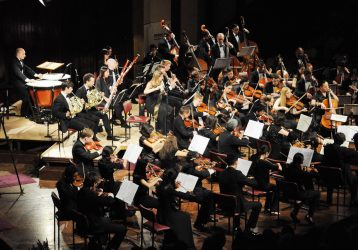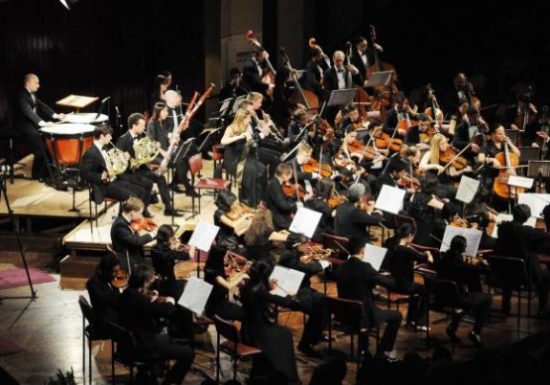 United Kingdom Williams, Brahms, Wagner: Pavel Kolesnikov (piano), Symphony Orchestra of Indian / Richard Farnes (conductor). Cadogan Hall, London, 8.12.2023. (MBr)
United Kingdom Williams, Brahms, Wagner: Pavel Kolesnikov (piano), Symphony Orchestra of Indian / Richard Farnes (conductor). Cadogan Hall, London, 8.12.2023. (MBr)

John Williams – ‘The Imperial March’ from Star Wars
Brahms – Piano Concerto No.2 in B-flat major
Wagner – Suite from Parsifal
Someone once said that if Mozart were alive today he would be writing film music. There are, of course, rather a lot of film composers who have written classical music – Miklós Rózsa, André Previn, Bernard Herrmann, Akira Ifukube – and John Williams. The genre can be enormously approachable to listen to (although I once lost a bet to name twenty atonal film scores) but I can’t recall ever going to a classical concert where a piece of music from a John Williams film score has been the opening work.
To place a piece from Star Wars before perhaps the greatest piano concerto ever written is certainly novel. I am not sure it worked for me, however. There is some truth that Williams does in ‘The Imperial March’ from The Empire Strikes Back get his inspiration from Gustav Holst, and most obviously from that composer’s ‘Mars’ from The Planets. They share the same surging, powerful rhythms, and the same terrific use of brass. But Williams is considerably more ‘motif’ oriented – and this does link more closely to the work that filled the second half of the concert, a vast orchestral journey through Wagner’s Parsifal – than any inspiration he got from planets elsewhere. Williams writes enormously vivid, beautifully crafted, and immensely striking music – and played well, as it was here, it creates another problem. You just want to hear more of it.
The Symphony Orchestra of India clearly enjoy playing this piece because the playing was superb – the brass notably controlled and secure with great tone. It would largely be the last time this was the case, however.
Johannes Brahms’s B-flat major Piano Concerto began – and continued for quite some time – in an unfolding arc of impending disaster; it became anything but that, however as a full-scale concerto performance. The pianist here, Pavel Kolesnikov, I think spent a considerable amount of time raging through everything that came before the second subject; but the sudden appearance of the key of F minor, the distant call of that solo horn, changed everything. The performance never looked back after that – and often reached heights of remarkable, penetrating brilliance.
Kolesnikov’s tendency to overstate scale at the Allegro non troppo’s opening, to make the flourishes down the keyboard sound enormously loud or stretch climaxes in a gruelling fashion were not particularly in alignment with adding to the music’s tension – rather, they were a distraction. Brahms is by no means understated here, but the convulsiveness of the playing was surely not what he would have had in mind for it. What he did, however, was the superlative handling of passages like the coda – Kolesnikov was spot on in a transcendental riot of quadruple octaves running down the keyboard, and a final triplet of chords that felt magnificently right.
The Allegro appassionata – basically a scherzo – had a good deal of spring to it, and his willingness to take Brahms’s writing at the right dynamic was impressive (the highly unusual pianissimo octaves, for example). Again, the coda was superlatively done. The Andante was uneven, and perhaps frustrating. In what should be a rather magical movement there was very often very little magic, despite Kolesnikov trying very hard to make a great deal of it and getting very little back for the considerable effort he put in. Although the orchestra’s solo cellist here, Sevak Avanesyan, often played with beautiful tone it rarely felt either haunting or profound; there was little tenderness between the cello and oboe (Richard Hewitt) either. Kolesnikov was considerably more successful in mirroring the other wind instruments in the orchestra – this felt rather more like a real constellation of stars and less like the yawning gap that existed across the chasm between the pianist and cellist as one looked forlornly towards the other.
The Allegretto grazioso had Kolesnikov in full flight, and as light as air as he glided around the keyboard with brilliance and agility.
Kolesnikov is certainly an interesting pianist. He might sometimes be a tad overzealous at the keyboard (although the beautiful way he plays is entirely gripping to watch); below the keyboard, Kolesnikov is, if not exactly a heavy-footed pedaller, then a distracting wood-thumper. Brahms’s B-flat is hard to bring off in most circumstances; this performance was, I think, eventually something of a minor miracle.

In the second half of the concert we had just a single work – Wagner’s Orchestral Suite from Parsifal, constructed by Andrew Gourley in 2018. Over the decades conductors have played orchestral this music to varying degrees – Eugene Ormandy perhaps more extensively than most, recording almost 50-minutes of the music with the Philadelphia Orchestra in 1956. Leopold Stokowski made his own Symphonic Synthesis, although this was only of Act III. Before Gourley made his own construction (which he recorded last year with the London Philharmonic), the most complete one had been done in the early 1990s by the Dutch musicologist Henk de Vlieger and, if memory recalls, this one differs slightly from Gourley’s – there is, I think, no Act III Prelude in de Vlieger, for example. Both Gourley and de Vlieger do not arrange the music in chronological order, but in essence this is barely relevant in a concert performance when the construction of the suite is as effectively done as it generally is in both versions.
I have largely considered Wagner’s Parsifal the composer’s greatest opera. But it poses clear problems, notably for conductors. The opening prelude to Parsifal can survive an inordinately slow tempo only if it has the right conductor who can make it do something else. On the other hand, a generally swift tempo, or one that is exactly on the tempo, can barely survive at all if it actually sounds as if it is somehow stuck in the trenches or wading through mud. Richard Farnes distinctly falls into this latter group. So excruciatingly slow did this feel I wondered if I would make my train home the same evening; and yet, when I looked at my watch it had been no faster nor slower than an average performance.
Farnes might, however, consider himself lucky because for all that mud I needed to scrape off my boots I did rather find the prelude rather involving as opposed to a snooze fest. It also turned out to be something of an aberration because almost everything else here moved more quickly (rather more quickly than Gourley takes in his own recording, in fact). Even if there were some insecurities in the brass, it was the string playing of the Symphony Orchestra of India that was the really compelling thing here. Wagner wants – and needs – a good richness of string tone, and we got it here, especially from some very dark and formidable double basses. The ‘Transformation Scene’ was superb. Parsifal himself richly observed with an ominous darkness. It might have been easy to have made all of this just sound overwhelmingly heavy-handed; instead, Farnes made this orchestral Parsifal gripping, mighty and yet growlingly powerful. Amfortas shone with brightness at the end. Pure radiance, I think – and just over forty minutes of Wagnerian indulgence.
Cadogan Hall typically plays to slightly smaller orchestras than the Symphony Orchestra of India – it was certainly nice to have seven double basses than the more normal five, for example. They are a splendid sounding orchestra and this innovative program showed that off to impressive effect.
Marc Bridle
